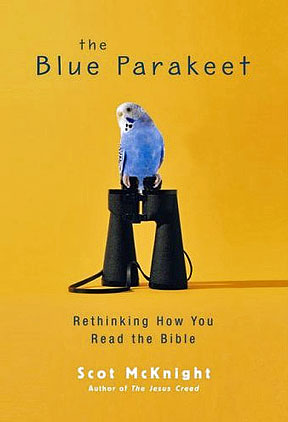 Yesterday I described Scot McKnight’s recent visit to Laity Lodge. Today I want put up a brief review of his latest book, The Blue Parakeet: Rethinking How You Read the Bible (Zondervan, 2008).
Yesterday I described Scot McKnight’s recent visit to Laity Lodge. Today I want put up a brief review of his latest book, The Blue Parakeet: Rethinking How You Read the Bible (Zondervan, 2008).
Initially, the most striking thing about The Blue Parakeet is it’s bright yellow color and odd title. What, one must wonder, does a blue parakeet have to do with reading the Bible? Scot explains this in what is effectively the second introduction to the book. As it turns out, McKnight is a bird-watcher. (A year ago I would have found this rather odd, but now that I live in a place with lots of interesting birds, I can relate to Scot’s fascination with our winged friends.) One day while he was watching sparrows in his backyard, Scot saw an unusual flash of unusual blue. It turned out to be a blue parakeet, no doubt an escaped pet. Scot was surprised, and so were the sparrows, who didn’t know what to make of the blue stranger. In time, they managed to get along with the parakeet, even though it had initially interrupted their routine.
According to Scot, there are passages in the Bible that are like this blue parakeet. They surprise us. They confuse us. They interrupt our otherwise comfortable reading of the Bible. What we do when we encounter these blue parakeets matters, especially for those of us who consider the Bible to be the authoritative guide for our faith and life. Scot explains his point this way:
Chance encounters [with blue parakeet passages] somtimes lead us deeper into thought. The passages I mentioned in the previous chapter [concerning Sabbath, tithing, foot washing, charismatic gifts, and surrendering possessions] as well as comments from students are for me “blue parakeet experiences.” When we encounter blue parakeets in the Bible or in the questions of others, whether we think of something as simple as the Sabbath or foot washing or as complex and emotional as women in church ministries or homosexuality, we have to stop and think. Is this passage for today or not? Sometimes we hope the blue parakeets will go away – as I hoped. (Kindle location, 357)
The rest of The Blue Parakeet is Scot’s effort to explain how we do and how we should interpret the Bible. In technical terms, this is a book about biblical hermenutics (the study of we interpret the Bible). It assumes the authority of Scripture and takes seriously the nature of the biblical text and especially its challenges for contemporary interpreters.
I found several features of The Blue Parakeet much to my liking:
• Scot’s style is casual and engaging. He has written for ordinary folk, not for scholars, though his ideas reflect a scholar’s knowledge. (Scot is a fine New Testament scholar and professor of biblical studies at North Park University.)
• He pays special attention to the narrative flow of Scripture and urges us to read biblical passages in terms of this narrative.
• He defends his positions strongly and clearly, though not tearing down those who would disagree with him. Scot is not a polemicist.
• His extended example of how we read biblical texts that speak of women in ministry is a helpful one. Even if you disagree with Scot’s conclusions, he’ll give you things to think about.
• He is honest about his own struggles to understand the Bible faithfully.
I would recommend The Blue Parakeet especially to Christians who are wrestling with how to interpret the Bible in a way that is faithful, both to Scripture and to our context today. I wish I had this book when I was in college and worrying about issues of biblical authority and interpretation. I could also see The Blue Parakeet being well used in adult class and small group studies.

